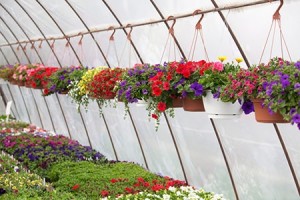 Read More in The Sun Gro’er Issue 1/1 (2003)
Read More in The Sun Gro’er Issue 1/1 (2003)
“For growers who desire low EC levels and do not want to leach the ideal solution is the use of growing media products with reduced nutrient charges.”
The measurement of soluble salts tests the “fitness” of growing media in the greenhouse. The amount of soluble salts is assessed by measuring the electrical conductivity (EC) of a mix. Watering practices have a dramatic effect on the levels of soluble salts in a growing medium. Salts originating from fertilizers or water provided to a crop can and will “build up” as leaching is reduced or eliminated. So a critical point to remember is that when growers reduce leaching for various reasons, especially with larger sized containers like hanging baskets, growers will most likely see higher EC levels. Invariably nothing has changed in the mix but the growing practice.
Often the practice of thoroughly wetting out the mix after planting is not conducted which tends to intensify the issue. When thoroughly wetting out the crop all the nutrient charge components are thoroughly and uniformly “activated”. This usually circumvents the problem. For growers who desire low EC levels and do not want to leach, the ideal solution is to consider Sunshine LB2 or other products having reduced nutrient charges. Then growers can have more control over their nutrient inputs and not worry about high EC levels caused by changes in irrigation practices. Speaking about irrigation practices, the encouragement of fungus gnats is always coupled with moisture. In recent years, the use of coconut coir pith, or coir, as a medium component has been promoted as a control measure to retard fungus gnat larvae from proliferating in growing media.
An article on this very question was published in HortScience (D. L Olson et. al., Volume 37 (6): 919). The research found that the inclusion of coir had no consistent significant effect on the reduction of fungus gnat larval counts in medium. The point is, if growers are looking for tools to battle fungus gnats, coir in the mix is not the answer. Instead, growers should begin with excellent greenhouse sanitation practices. Standing water or persistently wet conditions on greenhouse floors should be eliminated as much as possible along with the algae that often goes with it.
And speaking about sanitation and fungus, did anyone see the excellent article in Grower Talks (February 2003, p 70) about carry-over of Thielaviopsis basicola on reused plug flats? Researchers at NC State discovered that growers who reuse plug flats, and do not adequately disinfecting them, invite problems. Thielaviopsis basicola spores, called chlamydospores, are very resistant to environmental conditions and can persist for quite some time in the environment. This means that spores can readily “carry over” on flats, if not sanitized. And it depends on how flats are disinfected. Their work found that Zerotol at the 2.5 fl. oz. / gal. or bleach (9 water: 1 bleach solution) worked the best. The longevity of using these solutions are also contingent on the amount of organic matter being washed off the containers and growers should follow label recommendations closely.
When growers complain about disease on their crops always ask the question whether proper sanitation practices were carried out. Simple things like re-using pots or flats and how they are sanitized are fair game. Tried and true practices like working on clean and sanitized surfaces are paramount. Growers who finish crops should also inspect plugs, cuttings and the like for evidence of disease.
~Rick Vetanovetz
